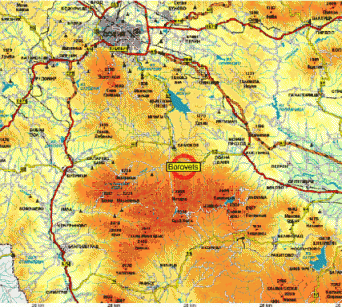Bulgaria, a rich history
Beyond the Borovets/Rila region, Bulgaria offers a rich variety of landscapes on both sides of the mountainous Balkan arc. Small country, Bulgaria brings together the exceptional beauty of its coastline sun bathed by the warm waters of the Black Sea and the imposing majesty of snow covered mountain ranges. On each of your trips you discover many monasteries, Roman and Byzantine ruins hidden in the folds of the mountains.
You will discover Bulgaria through festivals, music, dance, seasonal festivals and rituals, which form an essential part of Bulgaria to today. Craftsmen still practice coppersmithing, wood sculpture and potters perpetuate traditions.
Living culture
Country of mythical Orpheus and the legendary Spartak, the Bulgarian land is an ancient crossroad! It is the country where East and West meet, where history and future mix, and where cultures and traditions are alive.
Once upon a time the Thracians inhabited our lands. Millennium later, their ancient and mysterious culture was revealed in its magnificence. The unearthed Thracian gold treasures conquered the modern world and enabled a great civilization to take its deserving place in the history of mankind.
Our guests have long since esteemed the merits of Bulgarian cuisine with the verdict that it is tasty, spicy and varied, appealing to one and all. Indeed, who would not like the abundance of fresh fruit and vegetables, juicy meat, grilled or served with piquant sauces, the banitsa (cheese pie) which simply melts in your mouth, and the famous Bulgarian yoghurt?
Endowed with a sense of beauty and aesthetic sensitivity, the Bulgarian recreates his millennial history in poetic fairy-tales and melodious songs, fiery dances and vivacious celebrations, colorful ceramics and exquisite jewelry.
Bulgaria’s Unique Geography, and Traditions
Many visit Borovets for the cultural connection to the rich Bulgarian folklore traditions of the area, including hearty local food and wine, folklore evenings in private homes, picturesque nearby villages, historic sights and friendly people.
Bulgarian folklore evenings, featuring lively centuries-old rhythms and dances, along with other nightlife opportunities such as nightclubs, bars and discos, provide the entertainment, while typical Bulgarian cuisine and world famous Bulgarian wines satisfy the palate.
Bulgaria is world famous for its therapeutic hot springs. There are more than 5,000, most of them known since antiquity. The ruins of the baths built by the Romans are often still visible in their vicinity.
Furthermore, more than 30% of the territory is covered with forests and one cannot but be surprised by the richness of flora and fauna, or by the many national parks.
Wildlife includes red deer, wild boar, wild goat, foxes, rabbits, moles, and even small numbers of bears, and wolves.
Rila Monastery
The largest and most famous Eastern Orthodox monastery in Bulgaria. It is situated in the northwestern Rila Mountains, 117 km south of the capital Sofia in the deep valley of the Rilska River. Founded in the 10th century, the Rila Monastery is regarded as one of Bulgaria's most important cultural, historical and architectural monuments. It is on account of this also a key tourist attraction in Bulgaria and Southeastern Europe as a whole.
Rila Seven Lakes
Group of lakes of glacial origin, situated in the northwestern Rila Mountains in Bulgaria. They are the most visited group of lakes in Bulgaria. The lakes are situated between 2,100 and 2,500 meters elevation above sea level.
Each lake carries a name associated with its most characteristic feature. The highest one is called Salzata ("The Tear") due to its clear waters that allow visibility in depth. The next one in height carries the name Okoto ("The Eye") after its almost perfectly oval form. Okoto is the deepest circus lake in Bulgaria, with a depth of 37.5 m. Babreka ("The Kidney") is the lake with the steepest shores from the whole group. Bliznaka ("The Twin") is the largest one by area. Trilistnika ("The Trefoil") has an irregular shape and low shores. The shallowest lake is Ribnoto Ezero ("The Fish Lake") and the lowest one is Dolnoto Ezero ("The Lower Lake"), where the waters that flow out of the other lakes are gathered to form the Dzherman River.
Rila National Park
Rila National Park: There are four reserves which are included in the Park – "Parangalitza," "Central Rila Reserve," "Ibar" and "Skakavitsa." All these reserves are a part of the system that represents ecosystems in Bulgaria and Europe.
Climate
The altitude of Borovets above sea level is from 1230 to 1390 m. It is pleasantly cool in the summer (the average July temperature is 15.2°С), and the winter is mild and snowy (the average January temperature being 4.8°С).
The Bulgarian Economy - Still growing and plenty of room for more
Bulgarian Economy was still growing at over 7% in real terms in the first quarter 2008" to one source (economist intelligence unit) and to quote the European Union Economic and Financial Affairs:" New EU Member States Bulgaria and Romania have hit the ground running as they endeavor to narrow the economic gap between them and their peers. Despite the very real challenges facing the two countries, robust economic and investment growth are making the painful transition period in the early 1990s following the collapse of the Soviet bloc an increasingly distant memory. "ICPD – BECAUSE VALUE APPRECIATES".









